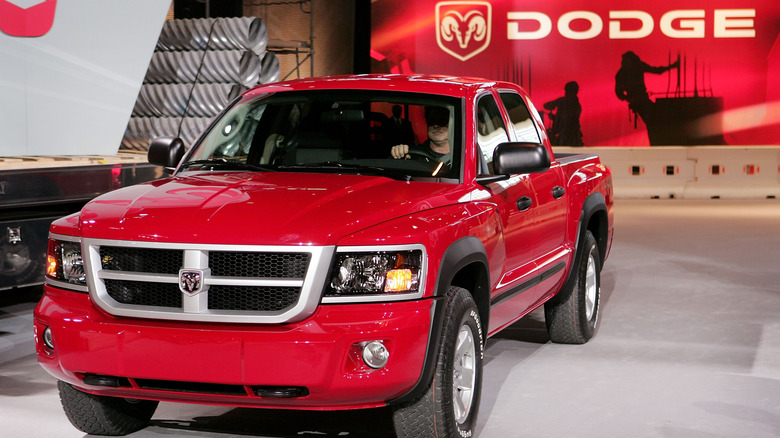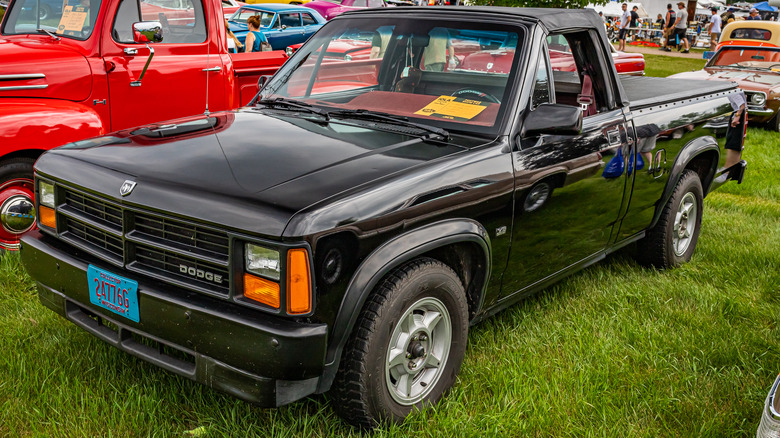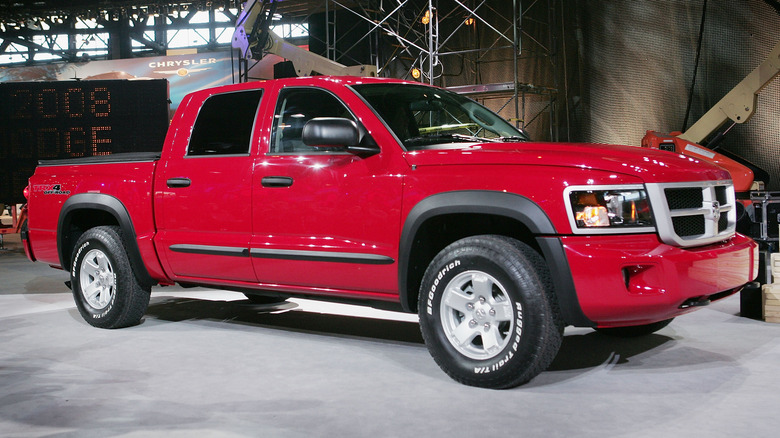Here's Why Dodge Discontinued The Dakota Pickup Truck
The cross-country roadtrip is an American dream, and I completed mine in a Dodge Dakota with my brother after graduating college. When we set off, that 2004 pickup truck already had 120,000 miles on it, and our months of travel added another 11,000 to its odometer. The 4-door cabin gave us all the room we needed for coolers of food and other supplies, while the truck bed, with a bed cap for cover, provided our sleeping quarters.
Through the dirt roads of Utah and the icy mountains of Montana, my Dakota held strong. In fact, the only damage it had after two months of long-distance trucking was a scratch on the tailgate (which could've been avoided had my brother not backed up into an "invisible" piece of rebar). When I returned from my travels, I had a deep respect for the Dodge Dakota line of pickup trucks.
Sadly, parent company Chrysler discontinued production of the Dodge Dakota in 2011, with no official statements why the decision was made nor if the Dakota line would ever return. The main culprit seems to be the waning popularity of midsize pickup trucks in the U.S. After all, full-size Dodge pickups like the Ram 1500 and 2500 are still selling like hotcakes, while the Dakota saw about a 90% drop in sales between 2000 and 2010.
But the reasons for the discontinuation — one of many for Dodge — are multi-faceted, and we can only speculate why it is gone, while hoping that it might return.
A great truck meets its end
Dodge's history includes iconic cars like the Grand Caravan, the Durango, and the highly anticipated all-electric Charger Daytona. But unlike the full-sized Ram pickups, the Dakota was conceived in the 80s as a midsize pickup truck with a more affordable price.
The first Dakota wasn't exactly a monster — the 1987 model was available as a straight-four or V6 engine. Many of these early trailblazers didn't even have power steering. If you wanted f4ur-wheel drive, you'd have to pick the V6 model, as the 4-cylinder model was strictly 2WD.The big precedent was the choice between a 6.5- and 8-ft bed, along with their corresponding 2-door and 4-door designs.
Other models quickly followed, like the Dakota Sport, which offered a V8 option. There was also the 1989 Dodge Dakota Sport Convertible, an exceedingly strange pickup that had a collapsible canvas roof. Why Dodge released such a bizarre (albeit admirably unique) is likely an indication of the earliest attempts to make midsize pickups desirable in a competitive marketplace where full-sized pickups reigned supreme.
But for all the fierce competition, the Dakota did well in its early years. The late 80s and early 90s saw roughly 70,000 to 90,000 Dakotas sold per year, and the turn of the century was the high-water mark for the Dakota, with over 144,000 sold in 1999 and over 177,000 sold in 2000. But sales soon took a turn for the worse.
21st century America prefers full-sized pickup trucks
The data is clear. Sales of the Dodge Dakota dropped dramatically as the 21st century progressed. In 2001, over 154,000 new Dakotas were purchased. Ten years later, in 2011, only 12,156 were sold. In all likelihood, Chrysler wasn't worried. Its full-sized Ram pickup had 344,538 sales in 2001 and 244,760 in 2011, an annual number that would rise to more than 630,000 in 2019. And that success persisted as the years went on.
It's obvious, then, what killed the Dakota: Supply and demand. These days, we're used to seeing expensive, gas-guzzling, full-sized pickup trucks on the road, while midsize and compact pickups are becoming a rarity. From the powerful 2025 Ram 1500 to the legendary Ford F-150 and F-250 models, and not to mention four generations of the GMC Sierra 1500 or the "rough-and-tumble" Toyota Tundra; all these recognizable pickups have V8 engines, 4WD, crazy horsepower, and massive beds. Midsize trucks like the Dakota are becoming a thing of the past.
But it's not necessarily the end of the road. Rumors have been swirling about a 2024 Ram Dakota, which would likely host many of the same components as its full-sized Ram 1500 relative. If such whispers are true, we may look forward to a revival of midsize, mid-price pickup trucks that a new generation can take on the great American road trip.


